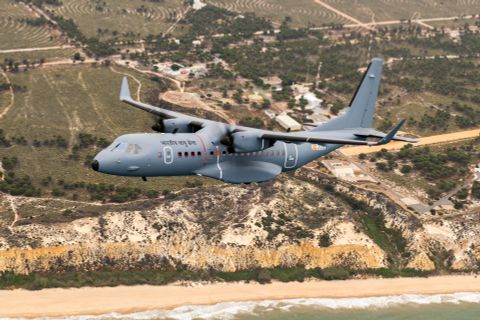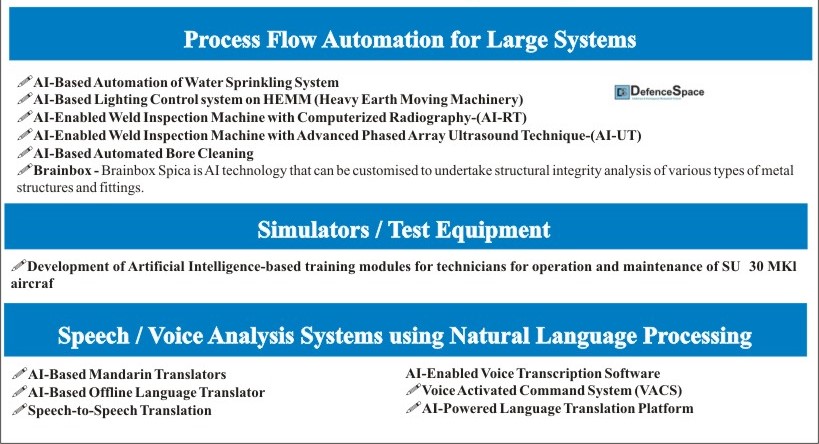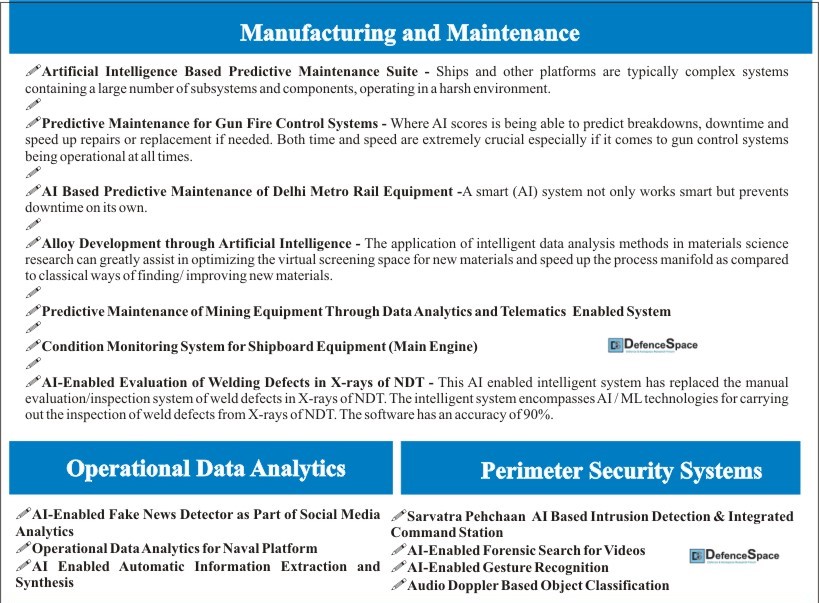BY KAVITA NAGPAL
Taking forward from our previous blog on ‘Artificial Intelligence (AI) in the Indian Defence Sector’ (https://thedefencespace.com/2023/06/13/part-4-of-the-series-artificial-intelligence-ai-in-the-indian-defence-sector/), in this blog post we will be covering few more AI-Technologies under Command, Control, Communications, Computer and Intelligence, Surveillance and Reconnaissance Systems (C4ISR) Systems – that are being indigenously developed or developing by the India’s Defence Industrial Base (DIB).
Refer the below given Image.
Command, Control, Communications, Computer and Intelligence, Surveillance and Reconnaissance Systems (C4ISR) Systems
1. AI-Based Intercept Management System (IMS)
Requirement: One of the major tasks in EW Operations is corroboration of helligence that requires analysis and interpretation of huge number of intercepts or generation of Common Operating Intelligence Picture (COP). The analysis, visualisalor interpretation and corroboration of such unstructured data is a challenging task. Further the predictive analysis of future operation events requires the support of Artificial Intelligence to plug the gaps. Hence, an urgent requirement was felt to design and develop Artificial Intelligence Based Intercept Management System.
Brief Description: IMS is indigenous software developed in house to analyse and automate intercepts of adversary in Western Theatre. The software makes use of visualization techniques and artificial intelligence to interpret op-critical data thereby generating accurate intelligence picture.
Salient Features: These includes of: –
- Identification and classification of operationally critical EW intercepts.
- Automated analysis and interpretation using artificial intelligence.
- Categorization and visualization of intercepts using data science tools.
- Creation, corroboration and migration of threat library.
- Records of audio intercepts to ensure integrity.
- Generation of Common Intelligence Picture of adversary based on probabilistic and deterministic approach.
2. AI-Based Motion Detection & Target Identification System in LC
Surveillance inputs of all EO/IO are in the form of real-time video feeds converging at the company posts/ Battalion Surveillance Centre/ Divisional Surveillance Centre etc. Manual monitoring of real-time continuous video surveillance is very cumbersome and monotonous in nature. At present, no system exists in the Indian Army which can automatically detect and classify objects for target identification.
Proactive Real-time Intelligence and Surveillance Monitoring System (PRISM) is an artificial intelligence based system which is the first-of-its-kind software in the Indian Army, capable of generating real-time audio/ visual alerts on detecting suspicious enemy movements from multiple surveillance inputs like PTZ Cameras, LORROS, HHTI, TTIOE etc. employed for monitoring real-time feeds from line of control, line of actual control and counter insurgency/ counter terrorism areas to perform realtime motion detection, target identification and tracking.
Salient Features: These includes of: –
- Real-Time Video Analysis
- Multi Class Object Detection
- Multi Point Camera Integration
- Night Capable Using IR &Thermal Vision
- Audio Alarm & Alert System
3. Continuously Observing Ubiquitously Available AI-Surveillance System
Existing surveillance equipment deployed for early warning of enemy intrusion, suffers from inherent disadvantages of line-of-sight limitations with deployment restricted to own side. It is resources heavy, with a high-power requirement and the need for continuous manning.
To obviate these restrictions, there was a need to develop a small portable surveillance system, which would be capable of processing images, extract relevant data and transfer the same to any control centre/ surveillance centre in the hinterland.
Features: These includes of: –
- Artificial Intelligence enabled and globally deployable.
- Data of enemy movement accessible at own surveillance centres/ decision makers in real time.
- No cable infrastructure required.
- High endurance, 200W inbuilt solar generator with foldable 50W solar panel for continuous operation with a power consumption of maximum 15W.
4. AI-Enabled Airborne Electro-Optic Infrared System
DRDO’s state-of-the-art AI-based object detection and classification system is based on advanced AI algorithms and helps many agencies including the armed forces when it comes to border surveillance and monitoring suspicious personnel and vehicular movement.
Unique Features: These includes of: –
- State-of-the-art Artificial Intelligence Algorithms
- Convolutional neural network-based Object detection
- AI-based Object Classification and Tracking
Applications
- Multi-mode maritime surveillance for ships, cruisers, tankers etc.
- Integrated coastal surveillance for objects of interests such as boats, trawlers etc.
- Border surveillance for various agencies for monitoring suspicious personnel and vehicular movement.
- Can be used in belly up / down position of the aircraft making it suitable for aerial surveillance of an area of interest.
- Ideal surveillance equipment for tracking of objects of interest such as vehicles, personnel or flying object for the police forces.
- Deep network-based Fusion of Day and Thermal Camera
- CNN and Farneback based Video Tracking
5. Deep Learning Toolkit for Aerospace and Defence
One of the most powerful and compelling types of AI is computer vision. This deep learning toolkit is capable of computer vision, NLP, reinforcement learning, sensor processing, tracking and fusion and a general adversarial network.
Unique Features: These includes of: –
AI-based Automatic Target Recognition involving
- ATR in Airborne Camera
- SAR ATR
- EO/IR Image/Video Fusion
- Oil Spill Segmentation
AI-based Sensor Processing involving
- IFF Mode Code Detection
- Target Detection from RD Map
- Tracking of Radar/IFF Measurements
- Sensor Data Fusion
- AI-based audio transcription and translation
- War-gaming Simulation using RL
- GAN-based Sketch-to-Image Synthesis
- Dual Domain Net-based Change Detection
Applications:
- Automatic Target Recognition
- Training of Pilots against intelligent adversary
- Validation of rule-based algorithms in various domains.
- Performance benchmarking against AI-based solutions.
- Range extension of surveillance sensors through AI-based signal processing.
- Online and offline Speech analysis of intercepted radio communication.
6. Adversary Network Analysis Tool (ANANT)
Law enforcement agencies need to understand and analyse data in two dimensions. Spatial and temporal data. Adversary Network ANalysis Tool (ANANT) offers spatiotemporal analysis to analyse multi-mode and multi-relational adversary networks, which are the current and future requirements of State Police and other Law Enforcement Agencies (LEAs). This product satisfies the static and dynamic network analysis needs of most of the LEAs under one roof. Potential users of this solution are State and Central Intelligence Agencies, Law Enforcement Agencies and Defence Forces.
Innovative features: These includes of: –
- Identification of Crime patterns
- Hot Spot analysis based on Crime type and Location
- Criminal Tracking
- Geo-tagged Sentiment analysis
- Crime Insights generation
- Risk Terrain Mapping Techniques to Identify Crime Vulnerabilities etc.
- Employs modern Predictive Policing techniques that not only predicts crimes by identifying areas at increased risk, but also Predicting approximate Geo location
7. Target Tracking for Complex Naval Scenarios
Traditionally, tracking of the Naval targets is performed using the correlation technique. However, in this product, AI-based techniques are used for detecting Naval targets. The Naval target tracking is extremely complex as the targets get embedded in the background. The system is useful in surveillance of naval targets for low range, mid-range and long-range applications. The position of the detected targets can be used for firing on the target.
8. Animal Detection for Railways
AI can help tremendously in the preservation and safety of the wildlife when railway lines pass through their territory. In the interest of wild animal safety and as an aid to the Railways, BEL has developed AI Model that detects wild animals like elephants, rhinos etc. from the video sequence and triggers an alarm to alert the train operator to take pre-cautionary measures.
This solution helps in avoiding wild life-train collisions on railway tracks by generating alerts/alarms to the train operator. It replaces the need for installing and maintaining fencing along the rail roads and reduces mortality due to accidents.
9. Enemy Aircraft Activity Recognition & Classification
AI can help identify enemy aircraft and even their plan of action. This makes it easier to take evasive action or launch an effective counter-attack. In an air defence scenario there is a high probability that threats will emerge in single or multiple groups and formations from the different parts of general hostile areas. They may take part in different kinds of fringe or coordinated attacks. Timely recognition and identification of such coordinating groups or packages, their activities and trends in real time and recognition of the adversary’s plan that is a possible enemy course of action, are immensely useful in any war or combat situation and particularly for air defence.
This solution has been developed using AI & Cognitive Computing techniques and is a first-of-its-kind in the country. This unique solution enables the users to automatically recognise and identify enemy aircraft’s plan from the observed activities well in advance, leading to improved situational awareness and enable to undertake timely countermeasures according to the identified plans.
Currently this solution has been developed for Air Defence System of the Nation and shall be implemented in IACCS. Further, this module could be utilised by other services e.g. Indian Navy, Indian Army for their air defence system to improve the situational awareness and response to any enemy intrusion into the air space.
10. AI-Based Anomaly Detection for Maritime Domain
Maritime Motion Pattern Recognition & Anomaly Detection is a novel approach for motion pattern extraction and anomaly detection in maritime vessel traffic, based on circular quad trees.
The approach builds/learns a model of normal behaviour inside the circular region associated with each node of the quad tree based on kinematic parameters such as location, course and speed of a ship. Based on the learned model for normal vessel behaviour, the method detects three types of anomalies viz. standard route deviation, speed and course variation. Methods of statistical estimation of probability distribution are used for normalcy modelling of kinematic parameters at each node of the quad tree.
Maritime surveillance is an important aspect to the national security and safety. The Maritime Motion Pattern Recognition & Anomaly Detection is an integral part of Sangraha (Maritime Domain Awareness & Decision Support System) delivered by BEL after replacing the M/S Raytheon’s Athena Software at Information Management & Analysis Centre (IMAC), Indian Navy. The advance decision support capabilities of Motion Pattern Recognition & Anomaly Detection are integrated with Chain of Static Sensors (CSS), Indian Coast Guard which currently in the deployment phase.
11. Passive Ranging using AI as a Classifier
The image range estimation system developed by BEL uses an artificial intelligence-based method to detect objects in the images and then uses pinhole camera geometry to estimate the range. It consists of 2 stages – object detection/tracking and range estimation. In the object detection/tracking stage, size and position of object in the captured image are determined. In the second step, range is estimated using the computed object size and real object size according to pinhole camera geometry. The system can estimate ranges of the object from a single image. Presently, the system works for vehicle and person detection and their range estimations.
This solution is useful for smart city applications such as “Forward collision warning (FCW) system” that detects vehicles ahead and issues warnings to drivers for avoiding or mitigating the harm caused by crashes. It can also be used in robots and in drones for object distance estimation.
Key Features: These includes of: –
- Works for a minimum object pixel size of 25*25
- Detects and estimates ranges for objects such as persons and vehicles
- Deep learning techniques are used for object classification
- Developed algorithm can be used in collision avoiding systems for vehicles in smart city applications
12. AI Based Passive TWS (Track While Scan) System
Artificial Intelligence (AI) refers to the simulation of human intelligence in machines that are programmed to think like humans and mimic their actions. AI plays an important role in homeland security applications like video surveillance, target tracking, image stitching in panoramic view, monitoring of activities around the borders for surveillance purposes, remote observation of important places and installations.
BEL has developed the PATWAR system for naval surveillance application mainly in the Defence sector where one can monitor objects of interest using a camera mounted on a Pan-Tilt Platform. The platform rotates the camera continuously which captures the images of the surrounding area being monitored. The PATWAR application generates a 360-degree panorama view of the surrounding area from the images received by the rotating camera and then it detects the objects of interest using deep learning.
The system provides a GUI where all the information like the generated panorama, live feed from the camera is displayed. It also provides a facility for the operator to see the zoomed-in version of the detected object by clicking inside the region provided around the detected object to get details of objects.
Salient Features: These includes of: –
- Real time streaming of IP camera.
- 360-degree panorama view generation.
- AI-based object detection framework to detect objects of interest in 360-degree panoramic view.
- Graphical User Interface. (GUI)
- Full view of detected object.
13. Development of Machine Algorithms for Maritime Anomaly Detection
Deep Darshak (TM) is a machine learning/AI based platform for carrying out analytics on AIS and other ship position data to assist the users in identifying vessels of interest and suspicious activity. The system uses deep learning, python algorithms and the latest data processing techniques to ensure safety and security of our seas.
14. Enhancing UDA by use of AI/ML and other Novel Techniques
Underwater Domain Awareness (UDA) is challenging and requires processing voluminous data (primarily acoustic in nature) to discern objects / sounds of interest amidst the background noise.
Ambient noise cancellation and the use of better algorithms / signal processing can also increase the range of detection. Underwater sensing is a key to enhance UDA. An Acoustic Vector Sensor Array (AVSA) can triangulate individual measured bearings to provide sound source localisation, thereby helping to characterise sounds specific to a source.
By utilising an array of three vector sensors, the application of beamforming techniques can provide sound source localisation, allowing for characterisation of the acoustic signature of specific underwater acoustic sources. Data from each sensor is agglomerated into an AI-based software and will confirm presence of underwater targets in the area.
15. AI/Big Data for Acoustic and Magnetic Signature Analysis
Currently, all activities – measurement of data, processing of data, generation of graphs to the creation of reports –is a separate manual activity making data processing & final report generation time consuming and susceptible to human errors.
This AI-based system for signature analysis is a project for Indian Navy’s Under Water Range (NUWR) at Goa. Proposed AI/Big Data solution will counter all the above issues.
- Raw acoustic data captured by sensors
- Broad and Narrow band Analysis done on captured data to identify cavitation inception speed
- Uses AI to identify inception of cavitation, tonals and correlate the tonals to data analysis reports.
- Magnetic data analysis is used to identify suboptimal surface, performance of vessel.
- Helps to reduce ship’s acoustic and magnetic signature optimizing stealth.
- Automation of entire process and handling big chunk of data.






One thought on “Part-5 of the Series – Artificial Intelligence (AI) in the Indian Defence Sector”
Comments are closed.